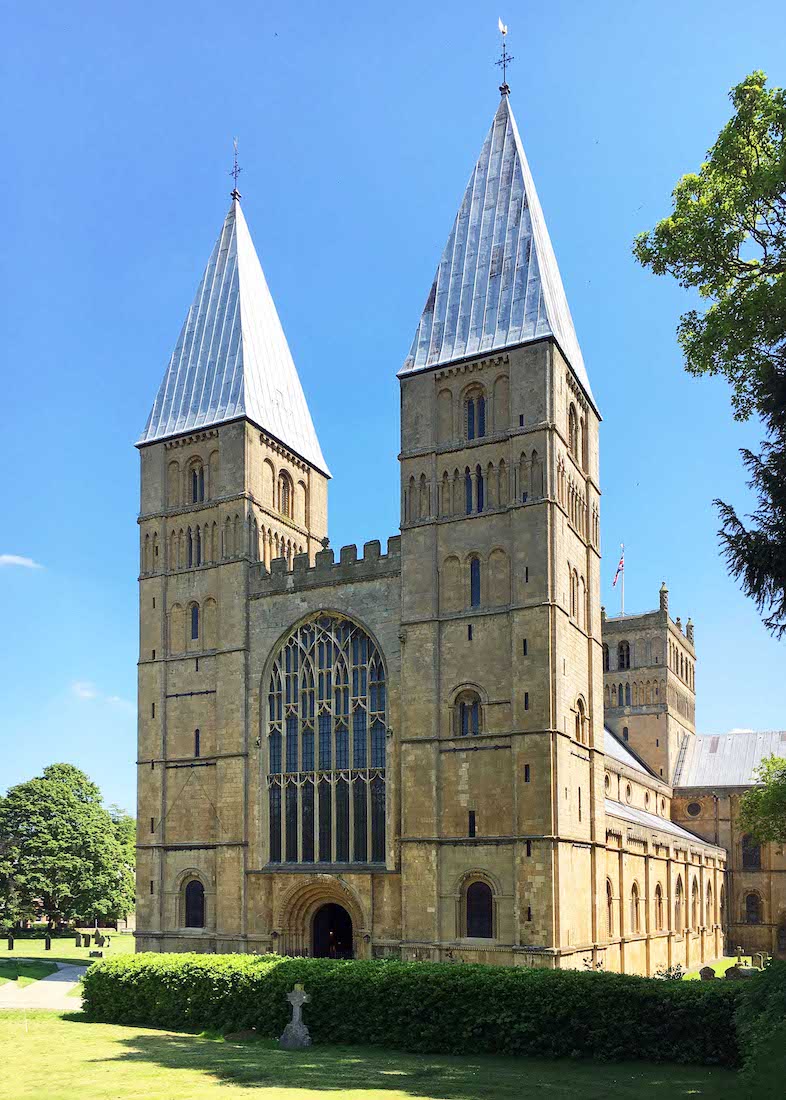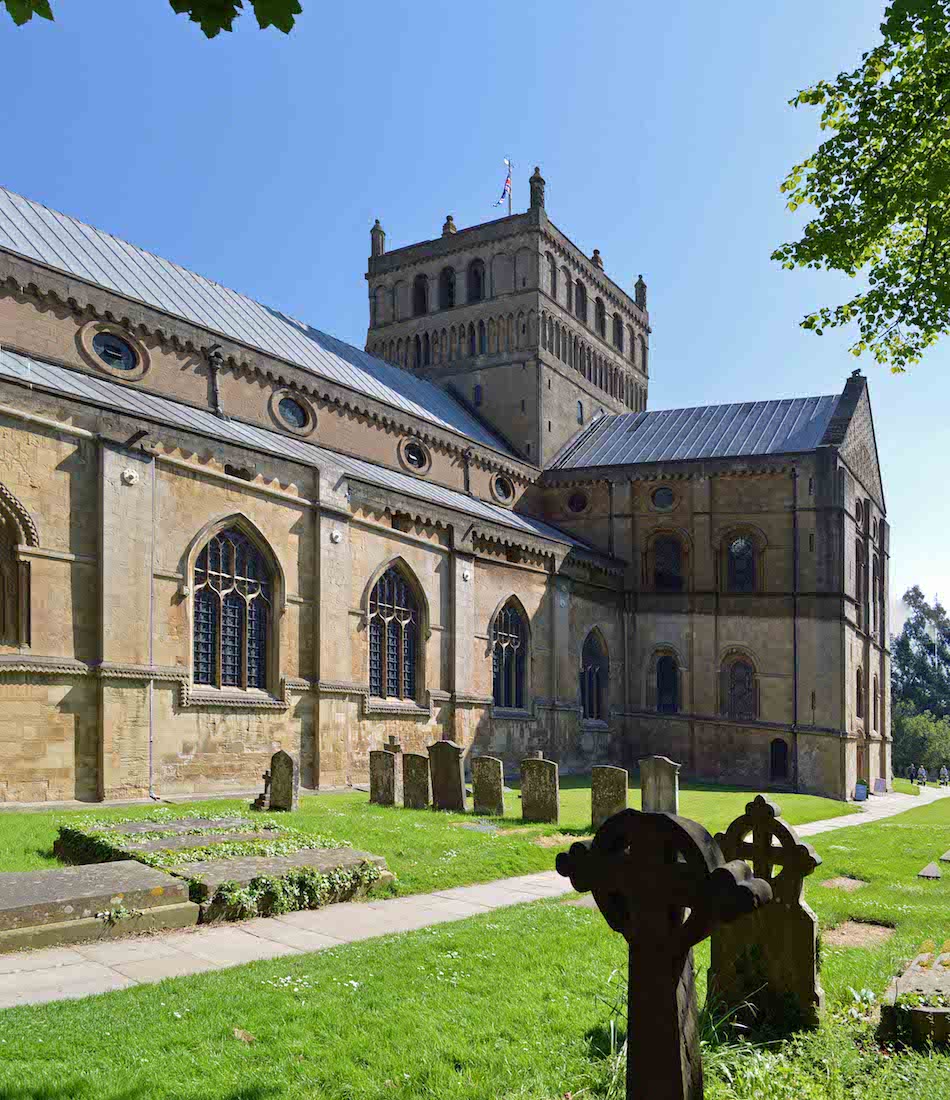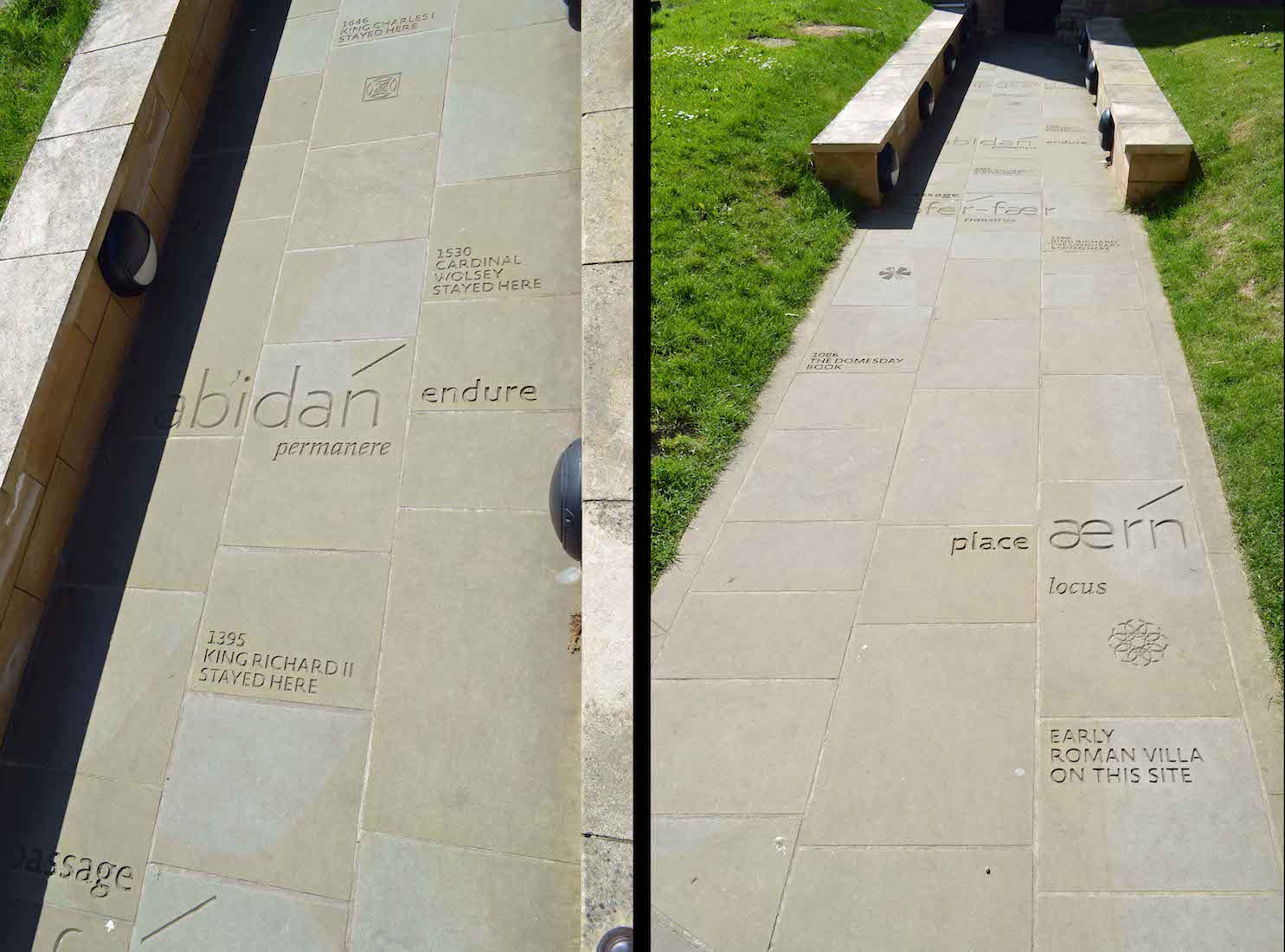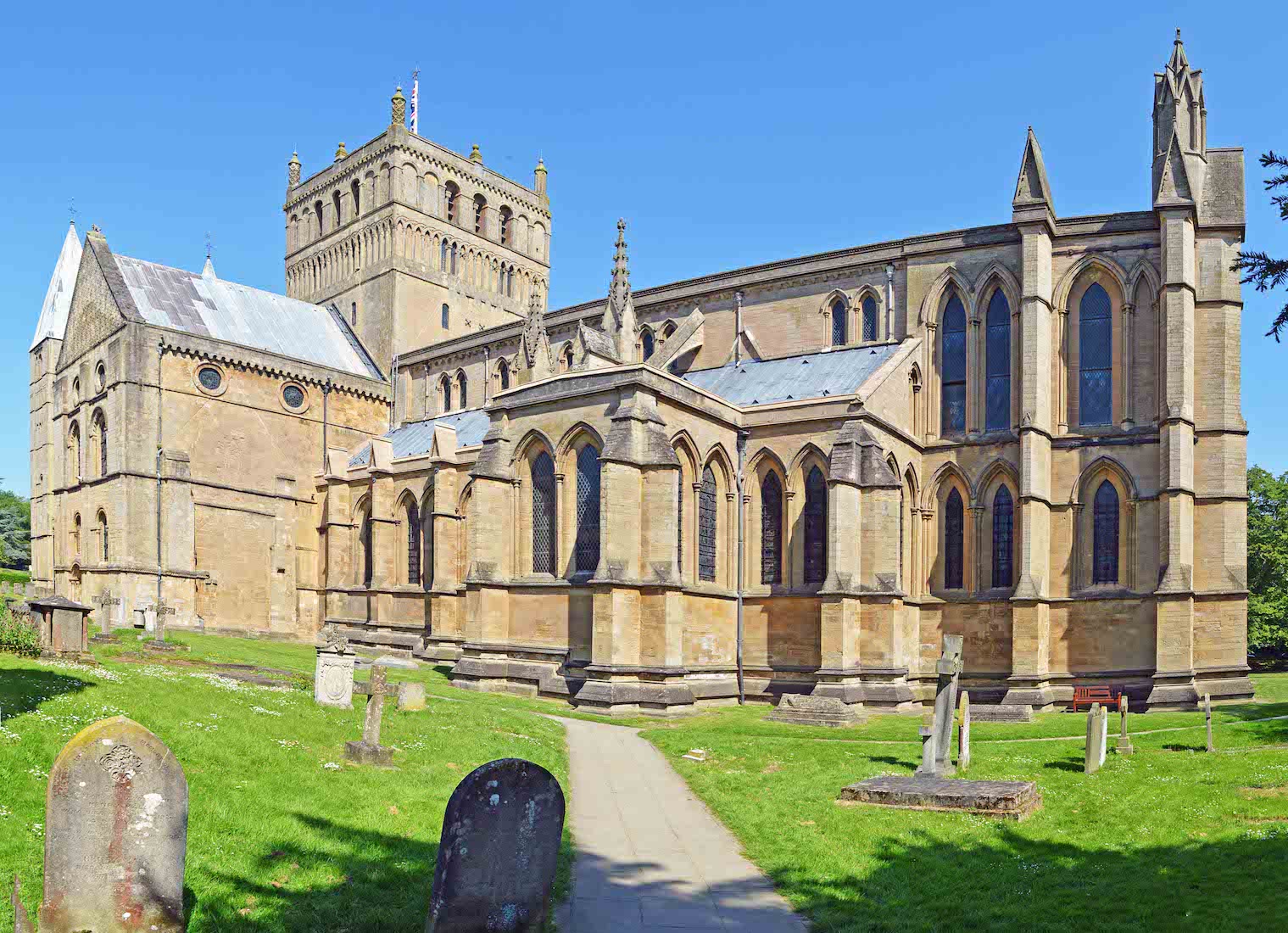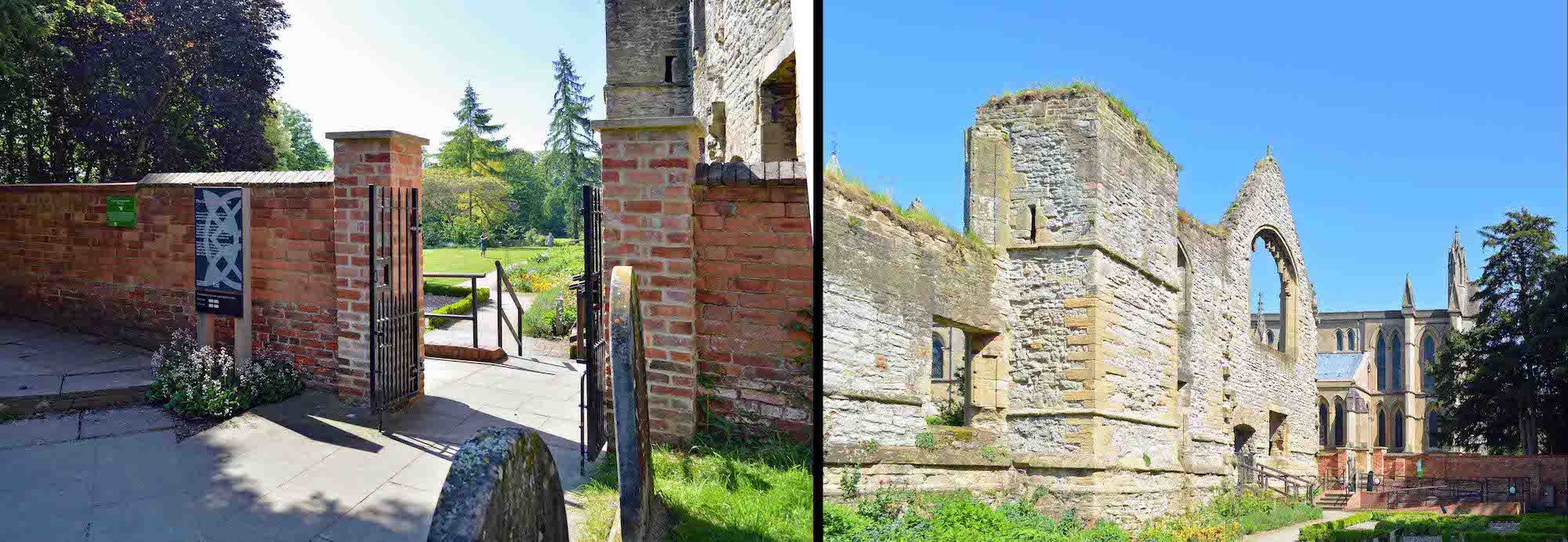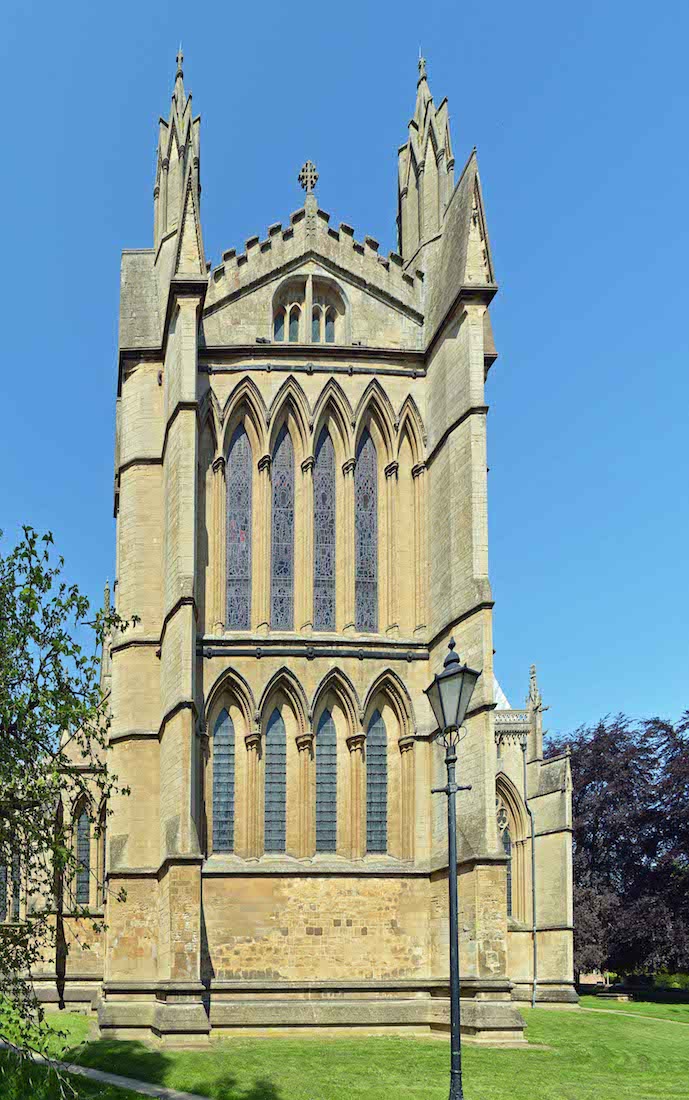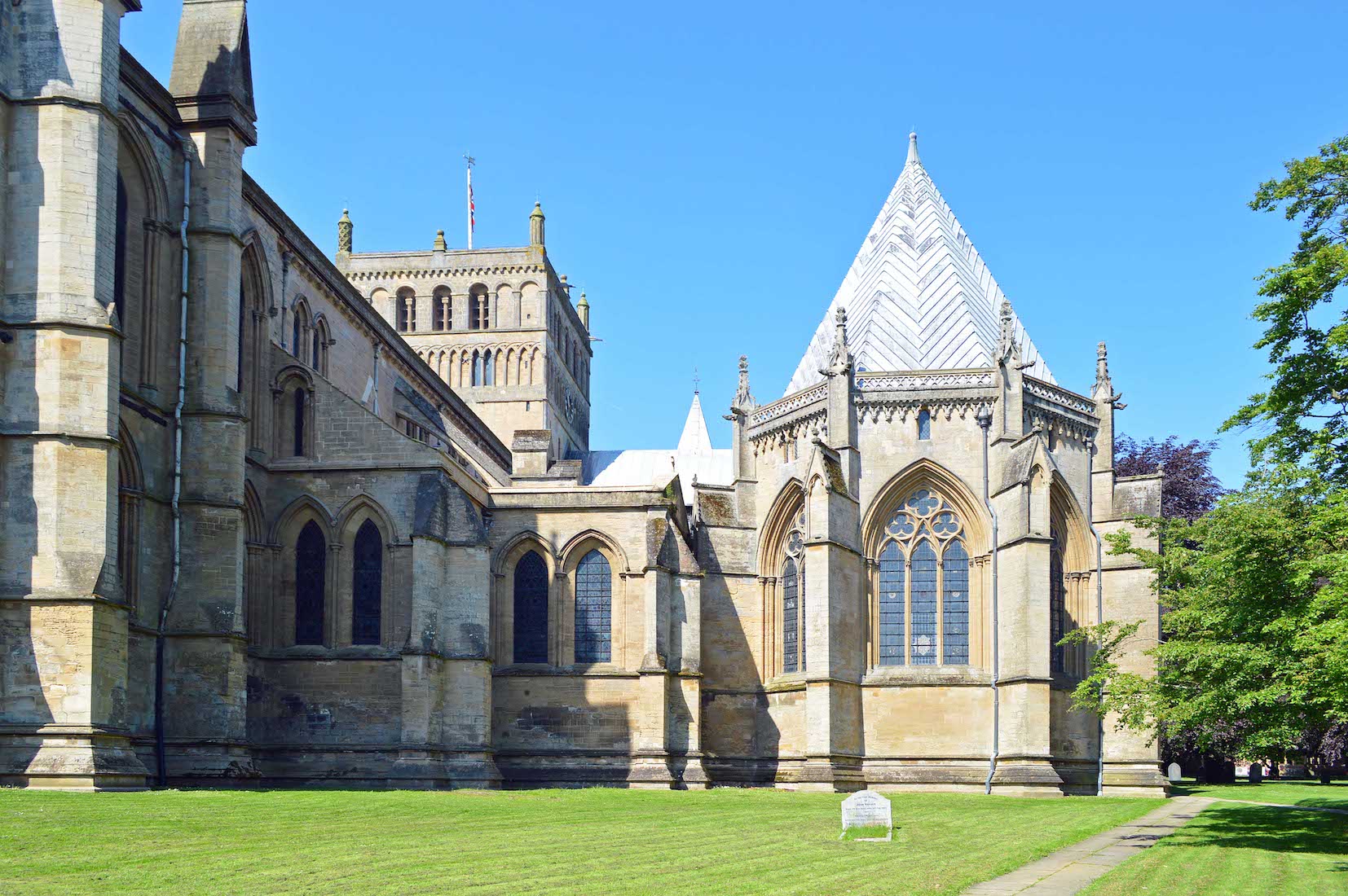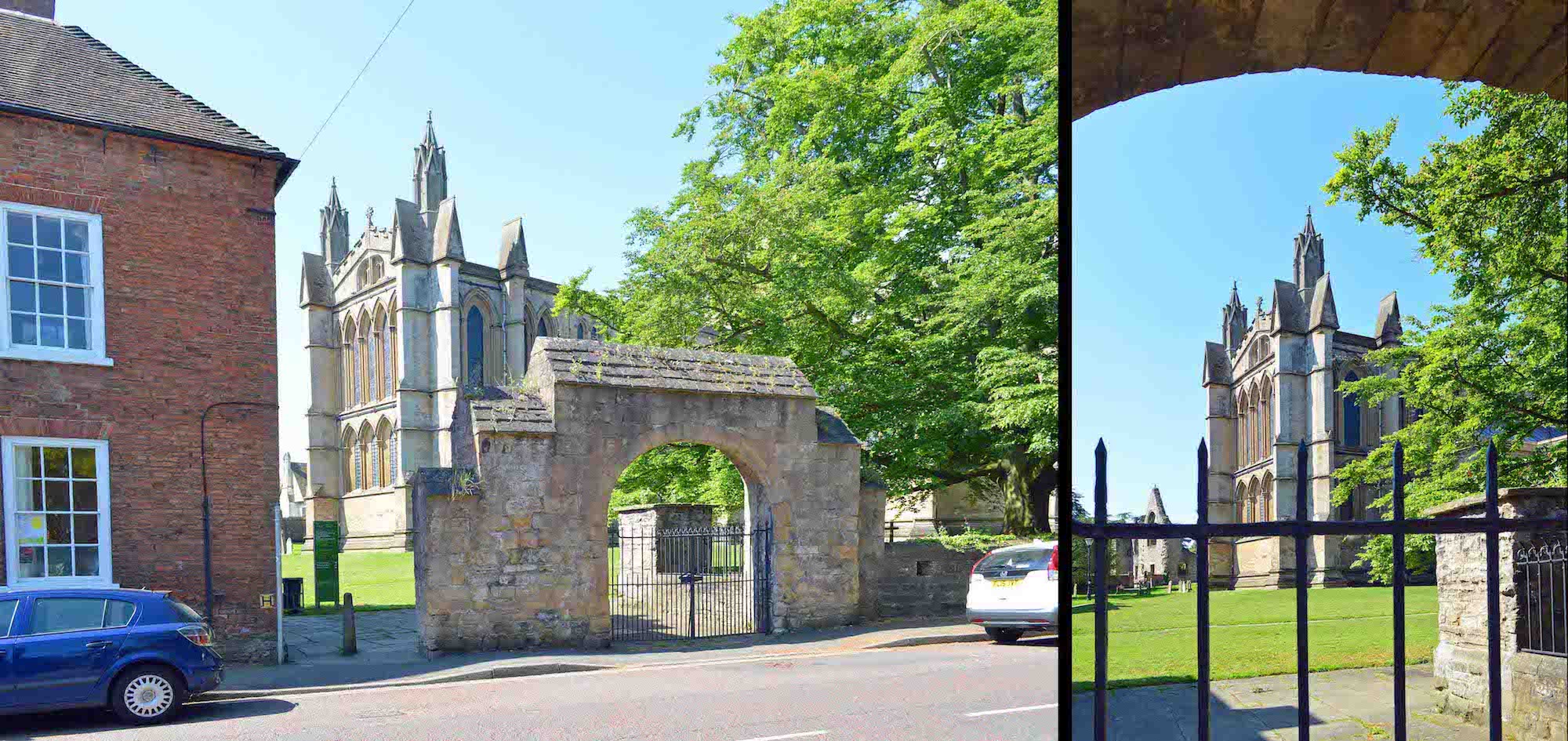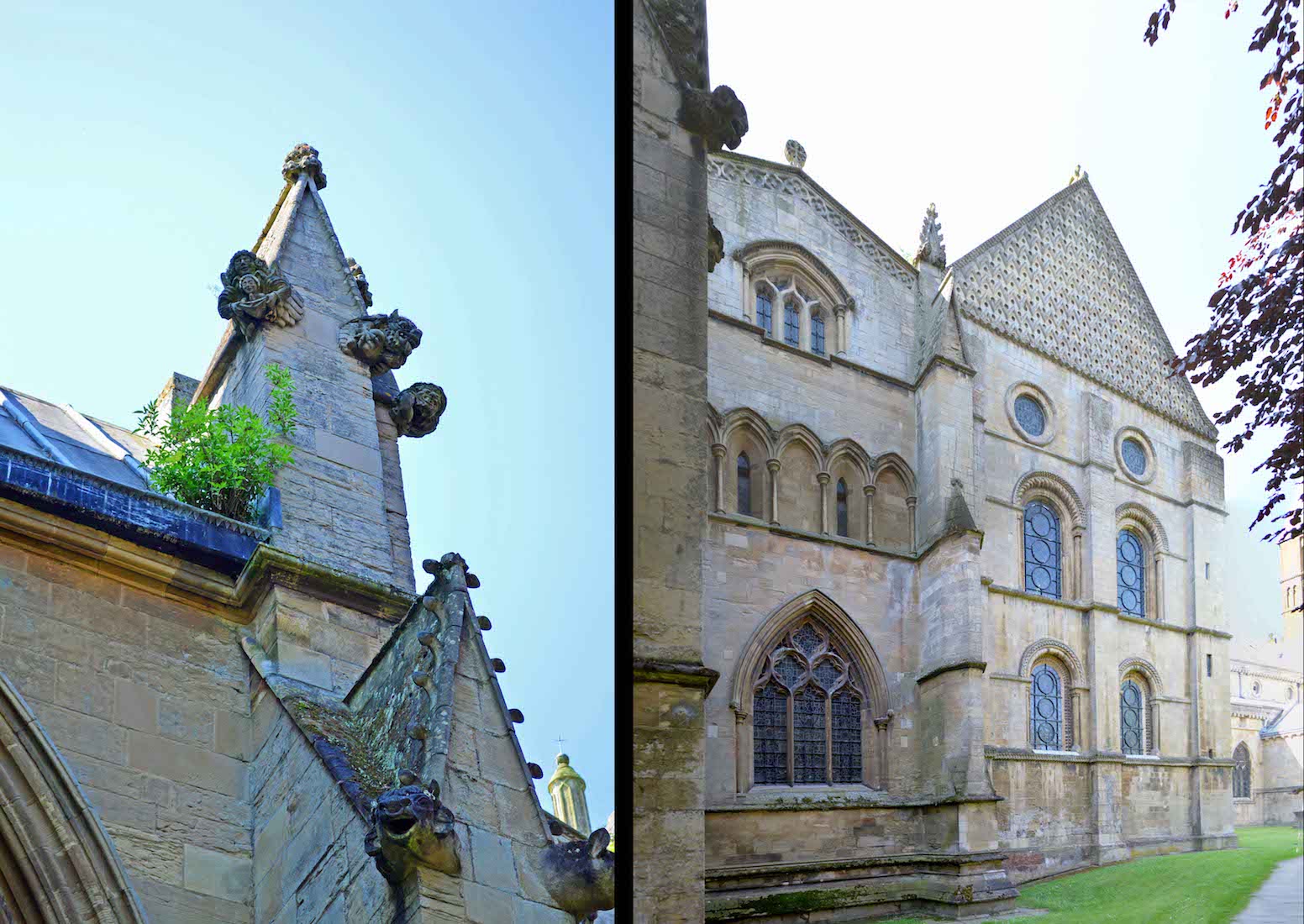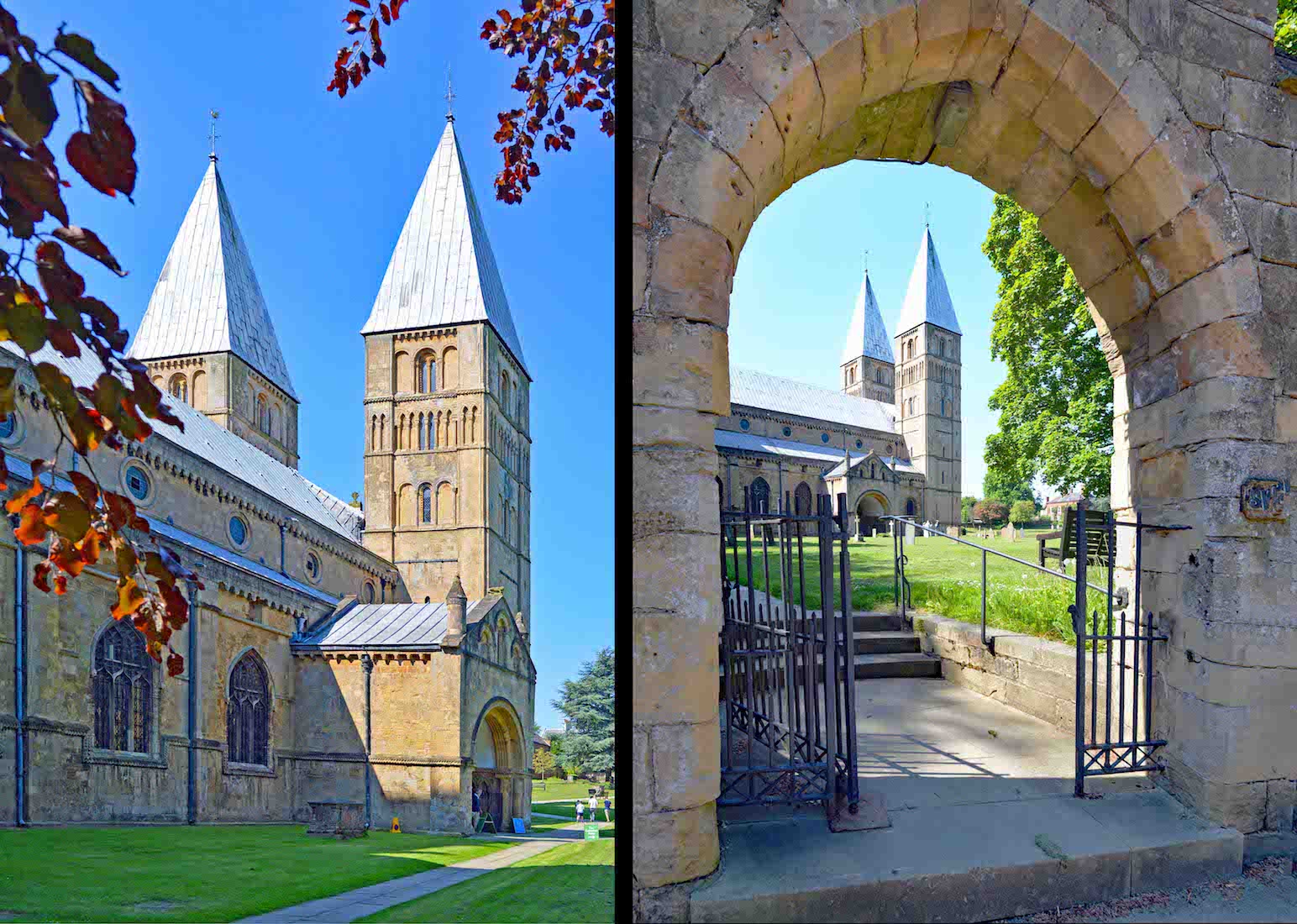
Southwell (sometimes pronounced Suth'ell) Minster is a minster and cathedral, in Southwell, Nottinghamshire, England. It is the seat of the Bishop / Diocese of Southwell and Nottingham. It is set in extensive grounds with this approach off Westgate. ••• The earliest church on the site is believed to have been founded in 627 by Paulinus, the first Archbishop of York, when he visited the area while baptising believers in the River Trent.. PLAN
2. ACROSS THE LAWNS

A path to the Cathedral leads from Westgate across lovely lawns with occasional headstones. ••• In 956 King Eadwig gave land in Southwell to Oskytel, Archbishop of York, and a minster church was established. The Norman reconstruction of the church began in 1108, probably as a rebuilding of the Anglo-Saxon church, starting at the East end so that the high altar could be used as soon as possible and the Saxon building was dismantled as work progressed.
3. WEST WALL
The Minster is the Cathedral and Parish Church of the Blessed Virgin Mary. The nave, transepts, central tower and the two Western towers of the Norman church which replaced the Saxon minster remain as an outstanding achievement of severe Romanesque design. The Western spires are 45m high. ••• The church was originally attached to the Archbishop of York’s Palace which stood next door and is now ruined. It served the archbishop as a place of worship and was a collegiate body of theological learning, hence its designation as a minster.
4. SOUTH SIDE PATH
It is our custom to circumnavigate each cathedral, where possible. With this in mind, we follow around the South side of the Cathedral. The building to our right now serves as a function centre and has public toilets. ••• The Norman chancel was replaced with another in the Early English style in 1234 because it was too small. The octagonal chapter house, built in 1286 with a vault in the Decorated Gothic style has naturalistic carvings of foliage (the 13th-century stonecarving includes several Green Men). The elaborately carved ‘pulpitum’ or choir screen was built in 1350.
5. CENTRAL TOWER
We come to the South transept, and the large square central tower. ••• The church suffered less than many others in the English Reformation as it was refounded in 1543 by Act of Parliament. Southwell is where Charles I was captured during the English Civil War. The fighting saw the church seriously damaged and the nave is said to have been used as stabling. The adjoining palace was almost completely destroyed, first by Scottish troops and then by the local people, with only the Hall of the Archbishop remaining as a ruined shell.
6. SOUTH NAVE WALL
From here we can look back along the nave to the distinctive Western towers. ••• On 5 November 1711 the Southwest spire was struck by lightning, and the resulting fire spread to the nave, crossing and tower, destroying roofs, bells, clock and organ. By 1720 repairs had been completed, now giving a flat panelled ceiling to the nave and transepts.
7. EAST FROM THE SOUTH TRANSEPT
Drawing level with the South transept, the South wall of the chancel comes into view. ••• In 1805 Archdeacon Kaye gave the Minster the Newstead lectern. Once owned by Newstead Abbey, it had been thrown into the Abbey fishpond by the monks to save it during the Dissolution of the Monasteries, and was then later discovered when the lake was dredged.
8. SIDE PATH
A new concrete path branches off here, leading to the function centre. It has various inscriptions carved into it. ••• In 1818 Henry Gally Knight gave the Minster four panels of 16th century Flemish glass (which now fill the bottom part of the East window) which he had acquired from a Parisian pawnshop.
9. SOUTHEAST VIEW
From the Southeast we see the South transept extending to the left, and the chancel/sanctuary to the right. In between are two chapels: The Chapel of Christ the Light, and St Oswald’s Chapel. ••• In 1805 the spires were In danger of collapse. They were removed and then re-erected in 1879–81 when the minster was extensively restored by Ewan Christian, an architect specialising in churches. The nave roof was replaced with a pitched roof and the choir was redesigned and refitted.
10. BISHOPS’ PALACE GARDEN
A gateway at this Southeast corner leads us from the Cathedral into a very pleasant Bishops’ Garden. The ruined walls of the Palace adjoin the garden near the gate. ••• Southwell Minster was served by prebendaries from the early days of its foundation. By 1291 there were 16 Prebends of Southwell mentioned in the Taxation Roll. In 1540 the prebends and minster were suppressed but an act of Parliament in 1543 re-established the college and church collegiate of Southwell.
11. TOWER AND CHAPELS FROM SOUTHEAST
This view is similar to a previous view, but it does show that some of the headstones are not particularly old. The headstone at bottom left is for George Pryor and his wife Mary Ann, both of whom died in 1914. ••• Under an Act of King Edward VI, the prebendaries were given pensions and their estates sold. The minster continued as the parish church on the petitions of the parishioners.
12. EAST WINDOW
This East wall has a grand façade with its narrow towers and ornate cross. ••• By an Act of Philip and Mary in 1557, the minster and its prebends were restored. On 2 April 1585 a set of statutes was promulgated by Queen Elizabeth I and the chapter operated under this constitution until it was dissolved in 1841. The Ecclesiastical Commissioners made provision for the abolition of the chapter as a whole; the death of each canon after this time resulted in the extinction of his prebend.
13. CHAPTER HOUSE
The beautiful chapter house stands at the Northeast corner of the Cathedral. ••• The chapter came to its appointed end on 12 February 1873 with the death of Thomas Henry Shepherd, rector of Clayworth and prebendary of Beckingham.
14. NORTHEAST GATE
The Cathedral has two side gate-ways leading out onto Church Street. ••• In 1884 Southwell Minster became a Cathedral proper for Nottinghamshire and a part of Derbyshire including the city of Derby. The diocese was divided in 1927 and the Diocese of Derby was formed. The diocese’s centenary was commemorated by a royal visit to hand out Maundy money.
15. SANCTUARY AND CHAPTER HOUSE
We continue our leisurely stroll, admiring the different aspects of the Cathedral. ••• George Ridding, the first Bishop of Southwell, designed and paid for the grant of Arms now used as the diocesan coat of arms. Its creation as a cathedral led to confusion concerning the civic status of Southwell. Traditionally the town might have been considered to be a city because of the presence of the Cathedral, but it has not been granted city status.
16. NORTH TRANSEPT
We come round to the North side of the Cathedral. Churches and cathedrals usually encourage new growth, but not of this sort! ••• The Friends of Cathedral Music was founded in 1956 by Ronald Sibthorpe prompted by a decision of the provost to abolish Saturday choral evensong so that lay clerks could watch football at Newark-on-Trent. I notice that at the time of writing [2019] Saturday choral evensong is being offered!
17. WEST TOWERS
Completing our circuit, we once again approach the Western towers, here nicely framed by the second gate-way to Church Street. ••• The earliest record of bells at Southwell is the gift of two bells to the church by Archbishop Kinsius, Archbishop of York, who died in 1060. In 1711 a violent thunderstorm passed over Southwell; a fire broke out in the Southwest tower burning the tower, and destroying the eight bells then installed. They were replaced in 1721.
18. NORTH PORCH TO WEST DOOR
We come to the North Porch, and we will enter the Cathedral through here. It is worth looking at the West door though with its typical Norman chevron markings in the arches. ••• In 1961 the bells of Southwell Minster were melted down and re-cast at the bell-foundry of Taylor’s of Loughborough. The original eight were recast and made into a peal of twelve, with a flat six, making a total of thirteen bells. As part of the 1960s re-casting, the floor of the ringing chamber was re-laid with oak timbers from Sherwood Forest.
19. NORTH DOOR ENTRY
Time for us now to enter the Cathedral. Even as I enter I have a sense of excitement: this very thick wall I am passing through, the nested Norman rounded arches leading to the door– all so old. What will we find?
20. NAVE
Once inside, we move to stand near the West doors and look down the nave. What to notice? The angled grey paving on the floor with the baptismal font at right. The solid columns with the round arches supporting the triforium gallery, and the narrower clerestory gallery above with its small circular light-giving windows. And above this the barrel roof with the Christ figure at the front. A fortress!


